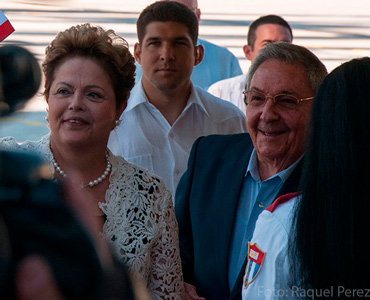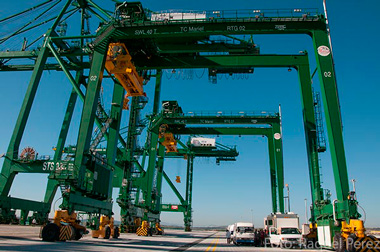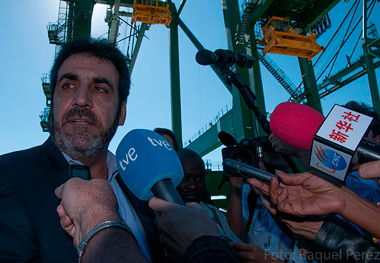Cuba Opens Most Modern Port in the Region

HAVANA TIMES — The presidents of Cuba and Brazil, Dilma Rousseff and Raul Castro, opened the container terminal at the Port of Mariel on Monday, the most ambitious and complex engineering work undertaken here in the last 50 years. Other leaders from the region were on hand to witness the ribbon cutting.
The project consists in building a port capable of receiving the Super-Post-Panama ships. The container terminal is designed to meet the needs of Cuba and provide services to other countries of the area .
Alongside the port a gigantic Special Economic Development Zone opens for business, hoping to receive foreign investments, which will operate governed by special laws and different ways of contracting labor.
The inauguration took place in the midst of the Second Summit Meeting of the Community of Latin American and Caribbean States (CELAC) , which takes place in Havana on Tuesday and Wednesday with the presence of all the nations of the continent except the US and Canada.
Cuba will invest over US $ 1 billion
The project gives Cuba the first port capable of receiving vessels of 200,000 tons. Its four cranes can move 822,000 20-foot containers each year, double the current capacity of the port of Havana.

To make it all possible, a channel was dredged at Mariel with a depth of 17.9 meters, enough for the larger vessels to enter. Such a work was impossible at the entrance of Havana Bay because it is crossed by a tunnel.
The project administrators say that Mariel is the most modern terminal in Latin America and the Brazilian president explained that the project was carried out with credits from her country, some $802 million dollars, that will be expanded by 290 million more in the next 24 months.
Virtually all of the workers (99%) that will be employed at the port will be Cubans, many of whom were trained in Argentina and China. Charles Baker, the terminal’s general director, told reporters that to expedite the process the operations are digitalized.
The controls are very strict, the facility has a plant to measure radioactivity and the incoming and outgoing containers are recorded with video cameras to register which vehicle transports the container and even who is the driver of the truck.
The administration is in the hands of a Singapore company that runs terminals in 15 countries, moves 30 million containers a year, and employs 29,000 workers. It is one of the best operators in the world, said Raul Castro.
A Cuban Hong Kong
The Mariel Special Development Zone is located 50 km west of the capital. It covers an initial area of 45 sq. kilometers but with plans to continue growing to 400 km2. The foreign investors will receive advantages similar to that of a free trade zone.

It appears what Cuban authorities seek at Mariel is a space free of the legal limitations that exist in the rest of the country after 50 years of socialist legislation, which limits business activity and economic growth.
There are already many Brazilian companies interested in investing, especially in agribusiness and in pharmaceuticals, said Hipolito Rocha, director of the agency that promotes trade between Brazil and Cuba.
Brazil is increasing its presence in Cuba; the Mariel project alone has included the participation of more than 400 Brazilian companies. Trade between the two countries now reaches US $500 million a year and investments are growing in sectors such as agriculture, with the technical consulting and sale of Brazilian equipment.
Meanwhile, Havana sells the Latin American giant medicines and contracts out health services. There are already several thousand Cuban doctors working in Brazil and it was officially announced that their number will grow this year to 11,000. Cuba receives US $4,200 per month for each physician.
—–
(*) An HT translation of the original report published by BBC Mundo.

Savannah port can only accept ships with a draft of 13,5 meters and a triple E vessel has a draft of 14.5 meters. Mariel can accept vessels up to 17.9 meters.
There are very few ports even in the US never mind South America that can handle the new triple E container vessels as they draw 14,5 meters. They are even too large to pass through the expanded Panama canal and barely pass through the Suez canal. They can carry 18000 20 ft containers, are much more efficient and can do 23 knots. Nicaragua has a big lake in the middle of it already and rivers from it that are navigable now. I think the only portion that needs building is from the Pacific to the Lake. The rest can be dredged were necessary.
The Chinese said 6 years, but why quibble? It is proposed to be 10 times longer than the Panama Canal and over terrain much more varied than the canal in Panama. Civil engineers who bid on the project say 6 years is impossible. But if you are in construction in year six and you are only halfway, so what? It is not like they can fire you at that point. What’s interesting is that Ortega says the small percentage of profits from the canal’s operation will make Nicaragua “financially independent”. From whom, you ask? From Venezuela. How’s that for solidarity and unity and all that bs. Ortega just got permission from his legislature to run for President forever so you see where this is going? Cuba 2.0.
Both China and the EU exceeded the US trade volume several years ago. So what? It stands to reason the a country like China of more than a billion people would engage in significant import/export trade. I understand the “dig” you were trying to inflict with the comment however. The “dig” is to divide that trade number by the total population to compute trade per person data. In this regard, the US remains the world leader. The Mariel Port is clearly dependent on the lifting of the embargo. Otherwise those large ‘container’ ships (thx by the way) would have to leave Cuba and not be able to call on US ports for 6 months. Even at #3 in total trade volume, the US market is impossible to avoid. The latest news is that the canal will not likely be finished, let alone in 5 years. Seems Ortega also has a problem with his indigenous population and their desire to preserve sacred lands, etc. http://www.bbc.co.uk/news/world-latin-america-25607757
Again, none of your points have any particular relevance for Mariel port and why it will be a commercial success.
Unless & until the US lifts the embargo, owners of ships will have a major disincentive to dock their ships at Mariel, whatever canal they use.
Two Brazilian companies have made agreements with Cuba to put plants in the new zone, one to produce high end glass and another for anti cancer drugs.
The expansion of the Panama canal is not completed and has come to a standstill for lack of finances. The Chinese gov expects the canal in Nicaragua to take 5 years to complete. The EU is not a country.
You are mistaken, as the article above states, the port will be operated by a firm based in Singapore, not China.
Early June 2011 it was announced that the contract for the operation of the future new Port of Mariel container terminal had been awarded by the Cuban government to PSA International, a leading global Singaporian port operator.
The EU leads the world in trade volume. China is 2nd, and the US 3rd. However, the majority of China’s trade is in Asia. The US still dominates trade in the Caribbean and Latin America.
It will take at least 12 years to complete the Nicaraguan canal and many experts think it won’t ever be finished. But even if it does, that does not change anything for Mariel. And the Castro regime does not have 12 years to wait.
I’m sorry but it doesn’t make sense. Your telling me that Chinese VLCS’s will transit the newly enlarged Panama Canal and instead of docking in Venezuela, Colombia, or some other South American destination (assuming the trade was not intended for the USA) they would instead travel several thousand more miles to Cuba and unload? And if the trade was destined for the US. There are more convenient destinations that accept these Very Large carrier Ships (Savannah GA being the most obvious)
Just in case you didn’t notice, China now has passed the US in world trade volume and I am sure that this project is more for the Latin American countries and the rest of the world not the US trade. China is also starting work on a canal through Nicaragua this year that can take the biggest container ships(not tankers Agent Moses) that at the moment can’t use the Panama canal. A Chinese company is also going to manage the port as it does in many other countries.
I assume by your comments that you support the Castro regime. Do you support the obvious wage-labor differential between Cuban workers and the workers in the country of origin. Isn’t this the first step in setting Cuba up as a sweat shop?
I think that one reason would be that this facility can handle the biggest container ships that draw much more water than many ports have in South America or North America for that matter (17.9 meters). They would be unloaded in Cuba and then loaded onto smaller vessels that can enter smaller ports. It is much more efficient to send them longer distances on the bigger ships and a short distance on a much smaller vessel. This also would play into the whole idea of a tax free zone at the port of Mariel to do assembly and manufacturing to be re- exported or to some extent put into the Cuban market.
The assumption that Cuba as the ultimate destination would not warrant the use of the supertankers. As the end consumer, Cuba does not the purchasing power to merit the big ships. Likewise, as a producer, there is not enough of anything in Cuba being produced for export to merit the this expansion. So the only other solution is that raw materials will be shipped to Cuba for assembly or processing in order to be shipped out of Cuba. If the Castros waive import/export tariffs on these raw materials hoping to benefit only from the labor fees, this whole things begins to make sense. The elephant in the room is that this deal highlights the relative low wages that Cubans will be earning working for these foreign firms. In Cuban terms, what seems like a good job is likely slave wages in Brazil. So it would make sense that Brazilian manufacturers would rather send the raw materials to Cuba and let Cubans put it together because it is cheaper than paying a Brazilian worker for the same work. So as Dilma Rousseff takes photos with Fidel to solidify her socialist street cred in Brazil, she is busy cutting deals that personify the “feral” capitalism so lovingly mentioned here at HT. Gotta’ love the irony!
Shhh… ¡Coño! Don’t ask such questions!
Obviously, Cuba has no internal market large enough to support the volume of imports from the Mariel port. The idea is to sell dirt cheap Cuban slave labour for the manufacture of products for export to other countries. This only makes economic sense so long as Cuban labour costs remain lower than that of Haiti or Dominican Republic.
They will still require a market for the cheap products, and as long as the US embargo remains in place, the biggest, closest market will remain closed. Furthermore, ships and containers which use the port will be banned from US ports for several months, as per embargo regulations. In the interconnected world of international shipping, that will be a major disincentive to docking at Mariel.
What else does Cuba have to offer? Modern management skills? High tech industrial knowledge? Full service commercial banking?
You can get a sense of the political purpose of Mariel, when every article about the port contains an aside about how the new port will force the US to lift the embargo, or else they will miss out on the coming bonanza. Yeah, Washington will get right on that.
Ultimately, the new port of Mariel is a Cuban Container Cult. The chief priest Raul believes that by building the trappings of a modern economy, his country will magically obtain a modern economy. In reality, it works the other way around.
This is not my forte so I apologize if this is a silly
question…. but why would cargo be unloaded in Cuba instead of
its intended destination? There certainly
is no consumer society in Cuba. There is also relatively little
infrastructure in Cuba
so I don’t see much manufacturing done there either. Is this a sort of, “if they build it they will
come?”